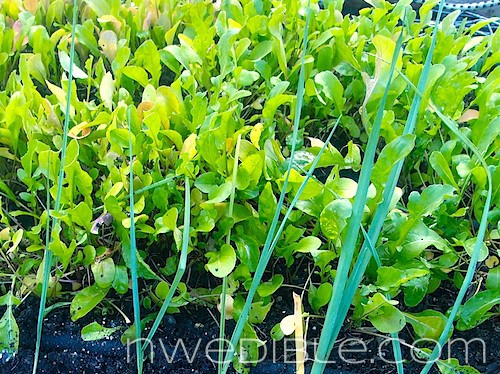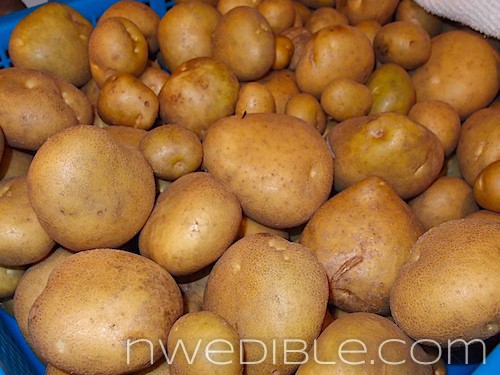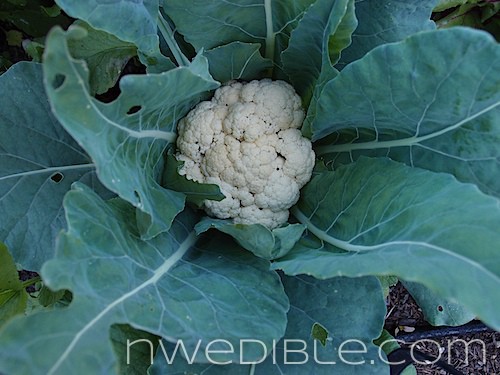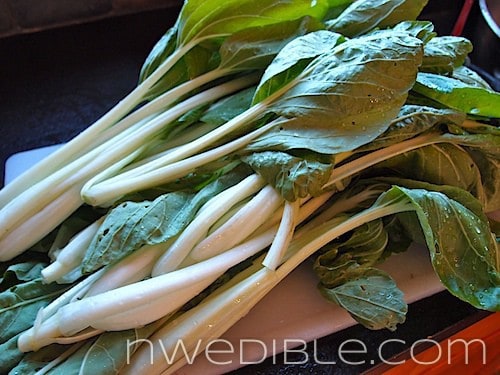This month, if you do nothing else – nothing – get your garlic in. With my eyes all wonky there is a very good chance that I will only be able to do (or delegate) a very limited number of things in the garden this month. My top three priorities are : garlic, garlic and garlic.
Plan & Purchase:
This is a great month to order bare root fruit trees and shrubs! If you didn’t get a garlic order in or save your own seed cloves, hit up your local farmers market or yuppie-hippie market and buy some hardneck garlic to plant now. My favorite variety is Music because the cloves are huge, but most of the hardnecks have great flavor.
If you don’t have cloches, buy or scrounge up the stuff you need to make them. We use PVC pipe hoops and 4 or 6 mil plastic sheeting for 6-8 week season extension and year-round weather protection for hardy edibles that are prone to rot, like endive. We dabble with Reemay and various spun row covers, but plastic sheeting, for all its many flaws, does create a nice grow environment more cheaply than just about anything else.
Sow Indoors
Nope, the lights are done for the year.
Sow Outside
- Garlic – The sooner you sow it, the bigger the cloves will get.
- Legumes – Some people grow overwintering peas, but I have not yet stepped up to this challenge. I’ve done overwintering favas with mixed success. In a mild winter they really do start blooming very early in spring. In a cold winter, the stalks die back to the ground and have to re-grow anyway once it warms up.
- Cover Crops -The easiest way to do cover cropping is to buy a blend that includes at least something from the legume family, like crimson clover. I also like to do edible cover crops of mustard, arugula or baby kales. In the Maritime Northwest, half the benefit of cover crops is in protecting the soil from pounding rain and compaction. If you do nothing else, put some straw or leaves or cardboard over your bare earth before the rains start in earnest.
- Late and overwintering greens – if you are using cloches, greenhouses or other season extension techniques, you can put in a direct-sown crop of fast-growing greens like winter lettuce, mache, arugula, mustard greens, spinach etc. and expect to harvest this year. Without season extension, much of what you sow out may not really grow a whole lot this year, but may size up beautifully very early next spring, before anything spring-sown could possibly mature.
- Overwintering root crops – you can also experiment with overwintering carrots, beets and other root crops. This year, an October 2011-sown patch of Mokum carrots provided us with delicious fresh and full size roots from May to July with very little damage from the root maggot.
Transplant Out
It’s a bit late, but if you have any lingering starts kicking around – chard, kale, lettuces, etc. – and you have a spot for them, why not stick them in the ground and see how they do? Get them under a cloche and they’ll probably thrive.
Harvest
Veggies
- Asian Greens – Bok choy, Napa cabbage, etc. are all coming into their own.
- Broccoli & Cauliflower – Broccoli came on a few weeks ago and I’d guess I’ve got 3-4 more weeks of pickings. This is why I like well-put together “blends” of things like broccoli. I harvested all my cauliflower as soon as it was ready because I know about this.
- Cabbage – The winter cabbage is sizing up nicely – I’m guessing it’ll be harvestable by Thanksgiving.
- Carrots – a few patches of late-sown carrots are hanging around but aren’t yet big enough to do anything with.
- Chard – Always chard. Always.
- Eggplant – still harvesting eggplant out of the greenhouse.
- Kale – The only thing more critical to grow than chard. Lots of decent size Cavolo Nero.
- Kohlrabi – I’m loving the way the Superschmelz Kohlrabi are sizing up. Already baseball size and looking at softball or larger size before I harvest.
- Lettuce and Greens – some lettuce has survived Slugfest 2012, and lots of baby arugula is growing around the winter leeks.
- Onions & garlic – From storage. Great garlic harvest this year, which is a relief after the garlic fail or 2011.
- Peppers – still harvesting peppers from the greenhouse.
- Potatoes – I’ve lifted all but some Yukon Gold type and some Russets. I’d say I’ve got maybe 80 or 100 pounds put by – I’m very happy with this year’s potato harvest! Lots of gorgeous French Fingering taters.
- Radishes – the ones sizing up now are less spicy than last months.
- Tomatoes – the last of the tomatoes will turn red in the next several weeks, or they’ll be picked green. This was a very disappointing year for tomatoes.
- Winter Squash – Will have to pick whatever the whacky volunteer winter squash gods saw fit to give me and make it work. I think I have a bunch of Green Hubbard and Acorn out there soaking up whatever last bit of ripening they can before the frost comes.
Fruit
- Apples – The apples are shining right now. So crisp and delicious right off the trees.
- Pears – Only a few Asian pears still on the tree, we picked a bunch and have them stored in the fridge where they will keep for weeks. The Euro pear trees around my neighborhood look loaded with fruit right around now. Last years espaliered Euro
- Plums – still a few Prune Plums hanging to the tree but they are mostly overripe and too soft now to really bother with.






I agree with you on cover crops and can’t say enough about their importance! I’ve been experimenting with them – rye and vetch last year, oats and radish this year. In addition to their soil protection benefits, they absolutely change soil for the better, especially new (freshly dug) soil that is a little hard and dusty. Austrian winter peas, IMO, are the primo winter cover crop for mellowing soil and changing it into that nice earthy “chocolate cake” consistency. Also a lot of evidence coming out that cover crops DO improve summer veggie quality and yield. http://plantcovercrops.com/cover-crops-provide-improved-corn-yields-in-on-farm-trial/
Hope your eyes unwonk immediately if not sooner. I always look forward to your next bit of gardening wit and wisdom. Take care.
We’re putting garlic, onions, more peas, beans, chard, radishes, tons of carrots, several different types of leaf lettuce and beets. I love having freshly harvested peas on Thanksgiving. Carrots grown during the “colder months” (which is a joke here in the desert of Southern Nevada) are much, much sweeter than the spring or summer harvests.
I also start my next-year’s compost mountain with leaves, grass clippings, tons of free horse manure and shredded paper. I usually make a 12-foot pile that eventually cooks down to about 2 feet of great compost by mid-summer.
Our favorite cover crop is the straw we mulch with (have to, because everything dries out instantly if we don’t) tilled in to where we have grown the peas and beans. By the time the harvest is over, the straw has really begun to break down and tilling it in finishes the job.
Hoping for the best with your eyes, my daughter has had to have the same type of thing done. She likes to say that she sees things differently than the rest of us, and I’m sure she does.
Where do you recommend ordering bare root fruit trees for here in the Northwest?
Raintree — tends to be on the expensive side, but selection cannot be beat:
http://www.raintreenursery.com/
One Green World — a good one for folks in the Portland area, as they deliver to many shows/locations (and also drivable to in Mollala), so you can dispense with shipping charges.
http://www.onegreenworld.com/
Burnt Ridge — best prices, especially for bulk orders, plants correspondingly a bit smaller/younger
http://www.burntridgenursery.com/
When are you coming over to my house to do all of these wonderful things? I have vodka……
So I took your advice and I planted cauliflower with the intent of overwintering it. I have a big healthy plant with no veggie in it…What do I do now? Do I cover it? Cut it back? Pull it and keep it alive in the garage? lol, just kidding about that last one. But really, what is my next step?
what variety of cauliflower did you plant and what area/climate/zone do you live in? Some varieties of cauli are bred for overwintering and will look like the most healthy big full plant for months and months and then, viola!, in feb or may you’ll have fresh cauliflower.
I bake over ripe plums on about 350 degrees, throwing in some sugar, cinnamon and vanilla. Stir hourly and within about 6 hours, you will have almost a plum butter consistency that you can can or freeze. It will keep in teh fridge for about a month, and is great on toast or yogurt.
However, I need advice about pears. Mine are hard, hard, hard. Will they soften on the kitchen table? Can I use them hard for jam and they will still taste okay? Help, please.
European pears should be picked mature but hard and left to ripen at room temp. If they come off the tree cleanly when you lift them up (like, turn them 180 degrees towards the sky) then they are ripe and ready for harvesting. Also look for a slight change in the background color of the fruit. More info here: http://www.denverext.colostate.edu/harvestingfruit.html
When is the best time to try to put in new beds? In the Spring next year or is now a decent time before the weather goes to…?
No now is ideal. You can fill your beds/build your beds with half-rotten compost and straw and leaves and all kinds of stuff that doesn’t “look” like soil and by spring planting it will be in excellent shape for your plantings.
Spring is upon us here in Australia.. I put garlic in 6 months, some of the plants have dried out at the top, and the scape may have been trapped inside, but most of the others are still looking healthy. We’re overloaded with mulberries, and the citrus are just finishing up -> already flowering again! yesterday I froze 6 ice cube trays worth of lemon juice and made mulberry cake, today: more lemons to juice (I should make preserved lemons) and grating the rind to freeze, mulberry muffins to bake….and hopefully the kids will help pick more to make jam. best wishes for your healing and all around health xx
Wow! That is indeed a great list to do. I think I must do my list to. It is indeed an amazing page. Cool!
Alice @ CheapSheds NZ LTD
I have a bumper crop of potatoes! How do you store yours? I’ve been digging up small batches and storing them in paper bags in the garage – this is fine for small amounts but I’m going to have to dig up a lot very soon. Thanks!
Thanks for saying your tomatoes were disappointing this year. Mine are still out there, green as can be.
Today I am searching for your thoughts on canning apples for pie. : )
I’m wondering about aphids on brocolli and kale… I haven’t found a good way to remedy them and hate to see stuff go to waste because of it… Any ideas?
The most effective thing if the infestation isn’t too bad at harvest time is to cut your broccoli into big, chunky florets (or even leave whole if it’s a small head). Get a pot of water simmering and dunk the broccoli in just briefly, florets down, while swirling aggressively. The aphids die in the hot water, lose their grasp and swirl out of the broccoli. Remove the broccoli so it doesn’t get overcooked and proceed with your recipe, using new clean blanching water if appropriate. This technique is pretty effective, but the best solution is to never get aphids at all. If I can figure out how to do that I’ll let you know. 😉